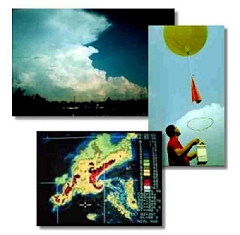Chapter 8
Weather Systems

"Forecast for this evening...dark"
~ George Carlin ~
Weather is the day - to - day state of the atmosphere. The weather of the humid tropics is very similar throughout the year as a constant flow of energy keeps temperatures uniformly high. However, the daily weather is quite variable in the midlatitudes. Here, huge air masses collide to create powerful storm systems that affect global heat distribution, the shaping of the earth surface, and our daily livelihood. In this chapter we'll examine weather systems at a variety of geographic scales that affect our daily lives.
Learning Outcomes:
By the end of the chapter you should be able to:
- Describe the conditions favorable for an air mass source region.
- Describe the characteristics of, and locate the source region for, cP, mP, mT, cT, cA, cAA mE air masses.
- Explain how air masses are modified when they leave their source region.
- Describe the characteristics of fronts.
- Identify cold, warm, stationary and occluded fronts from a weather map.
- Interpret weather conditions from weather maps symbols.
- Describe the polar front theory of cyclogenesis.
- Draw profile views of cold, warm and occluded fronts.
- Explain the relationship between jet streams and surface cyclones.
- Describe the weather changes that occur as a midlatitude cyclone passes.
- Compare and contrast conditions during the cumulus, mature, and dissipating stages of thunderstorm development.
- Describe how lightning forms.
- Describe the conditions necessary and location for hurricane development.
- Describe the potential impact of global warming on severe weather.
See if you are prepared for this chapter by Getting Ready for Chapter 8: Weather Systems.
You may view a list of chapter topics by clicking the "Topic Outline" link or go directly to the first topic by clicking "Continue".
Previous | Topic Outline | Continue
